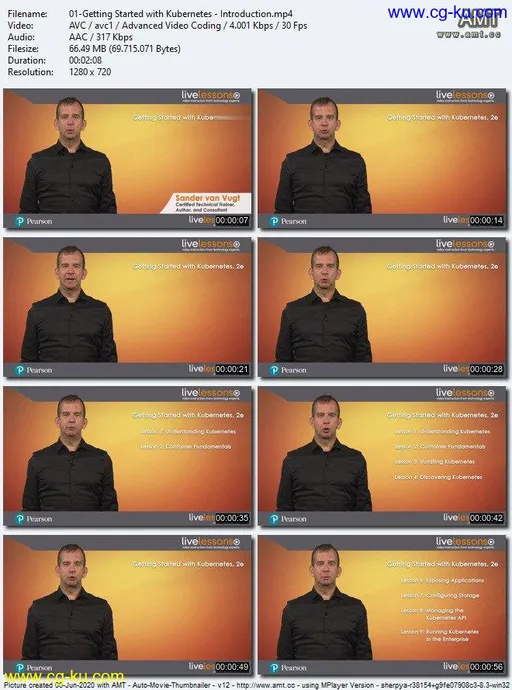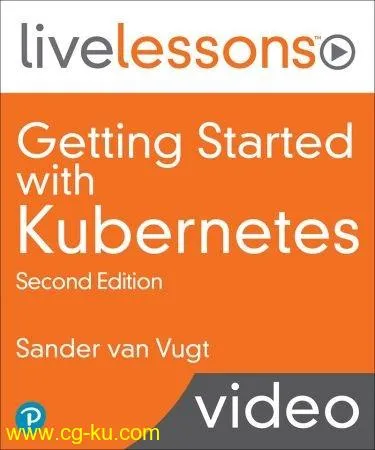MP4 | Video: h264, 1280x720 | Audio: AAC, 44.1 KHz, 2 Ch
Genre: eLearning | Language: English | Duration: 87 Videos (6h) | Size: 6.1 GB
6+ Hours of Video Instruction
More than six and a half hours of video instruction, including demos and labs, on how to get started with Docker Containers running as replicated Pods in Deployments in a Kubernetes environment.
Overview
This all-new edition of Getting Started with Kubernetes offers a complete overview of everything needed to start working with Kubernetes. It starts by explaining what Kubernetes is all about, and then moves into an overview of working with containers. This course first demonstrates how to install Kubernetes and then walks the viewer through core Kubernetes components, including how to use them running applications in Pods and deployments. The course then moves through networking and storage, as well as the role of the Kubernetes API. Finally, it discusses how to run Kubernetes in the Enterprise, and how to troubleshoot it in case it doesn't work out well.
Topics include:
Understanding Kubernetes
Container Fundamentals
Installing Kubernetes
Discovering Kubernetes
Managing Kubernetes Applications
Exposing Applications
Configuring Storage
Managing the Kubernetes API
Running Kubernetes in the Enterprise
Managing Kubernetes in the Enterprise
Troubleshooting Kubernetes
About the Instructor
Sander van Vugt has been teaching Linux classes since 1995 and has written more than 60 books about different Linux-related topics, including the best-selling RHCSA-RHCE 7 Cert Guide. Sander is also the author of over 25 video courses, including the CKAD and CKA Complete Video Courses. He teaches courses for customers around the world, and is also a regular speaker on major conferences related to open source software. Sander is the founder of the Living Open Source Foundation, a non-profit organization that teaches open source to talent in different African countries.
Skill Level
Intermediate/experienced Linux administrators
Learn How To
Set up Kubernetes for container orchestration
Use Docker within a Kubernetes environment
Set up a lab, and use Minikube
Work with kubectl and YAML files
Deploy applications in Kubernetes
Use pods and replica sets, and labels
Manage Namespaces and deployments
Scale deployments up and down
Work with networking in a Kubernetes environment
Network within a pod, and work with ingress
Store data in Kubernetes with persistent and non-persistent volumes
Understand dynamic provisioning
Work with secrets and configmaps
Work with Helm charts and other tools to manage Kubernetes in the enterprise
Set up Kubernetes in different public cloud environments
Build an on-premise Kubernetes cluster
Get information from the API
Learn to troubleshoot Kubernetes
Who Should Take This Course
IT Staff (administrators and devops) who want to offer containerized applications to their users
Course Requirements
At least one physical machine with 4GB of RAM or more to use as the Kubernetes host
Lesson Descriptions
Lesson 1: Understanding Kubernetes
This lesson starts with a brief overview of containers, as well as explains the requirements for working with containers in a corporate environment. The lesson then covers the rise of Kubernetes, as well as the Kubernetes ecosystem.
Lesson 2: Container Fundamentals
This lesson explores containers, which is required before learning how to manage containers in a Kubernetes environment. It starts with an explanation of the nature of a container, then moves into container architecture and the different container offerings. The lesson then teaches how to work with two common container technologies: docker and podman. This lesson also looks at some day-to-day container management tasks, which are managing container images, operational container management, container networking, and container storage.
Lesson 3: Installing Kubernetes
In this lesson, the various Kubernetes installation options are explained, and installing Kubernetes using Minikube is demonstrated. The lab in this lesson has you doing this on your own.
Lesson 4: Discovering Kubernetes
This lesson starts by explaining the dashboard, which allows for easy deployment of applications. Next, working with kubectl, which is the core utility for working with Kubernetes, is covered. Enabling kubectl tab-completion; working with YAML files; and learning about core Kubernetes objects, as well as the API, are covered.
Lesson 5: Managing Kubernetes Applications
This lesson is about managing applications in Kubernetes. This lesson covers how to work with Pods and deployments. The use of namespaces, application scalability, and application updates and rollback are covered.
Lesson 6: Exposing Applications
This lesson starts with a generic overview of Kubernetes networking, and then goes on to Pod networking. The lesson then moves into DNS in Kubernetes, as well as working with Ingress.
Lesson 7: Configuring Storage
This lesson starts with a look at Pod volumes. Next, it explores how to decouple storage by using Persistent Volumes and Persistent Volume Claims, as well as configuring the Pod to use these. The lesson ends with information about configmaps and secrets.
Lesson 8: Managing the Kubernetes API
The Kubernetes API is where all resources are defined, which is primarily what this lesson covers. This lesson also explains how to use kube-proxy to connect to the API, and how to use curl to connect to the API directly. Based on this knowledge about the API objects, the lesson then delves into kubectl explain, which helps in understanding what all these resources are about.
Lesson 9: Running Kubernetes in the Enterprise
This lesson covers getting started with Kubernetes in Google Cloud, Amazon, and Azure, as well as how to build your own on-premise cluster using kubeadm.
Lesson 10: Managing Kubernetes in the Enterprise
This lesson focuses on Kubernetes features that make sense in production environments. First, the different setup options are explained, followed by high-availability. Next, it dives into helm charts and exploring the metrics server, which allows for monitoring Pods. The final video in this lesson is about network plugins.
Lesson 11: Troubleshooting Kubernetes
This lesson covers the different areas of troubleshooting, starting with troubleshooting of applications that are running in Pods. Next, troubleshooting Pods and other Kubernetes objects are discussed. Then the lesson looks at cluster-specific problems, as well as authentication and authorization issues.


发布日期: 2020-06-06